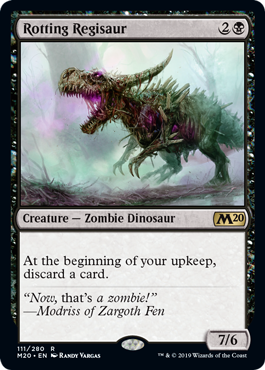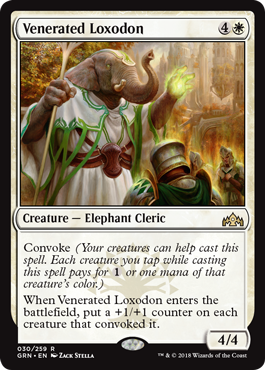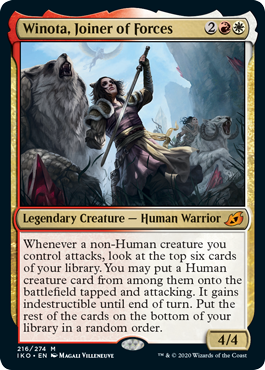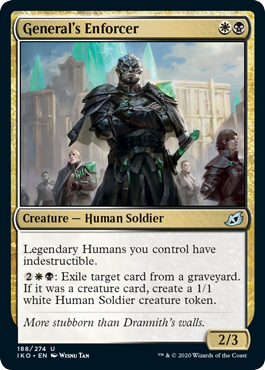The Magic community has filled great tomes with the discussion of the 2019-2020 Standard environment; at this point, it’s hard to justify repeating the analysis in detail. Suffice to say that the format is historically short on deck variety, and one reason why is how incredibly hard it is to play aggro decks right now.
Standard has been dominated by UGx ramp decks essentially since War of the Spark released. The combination of Teferi, Time Raveler discouraging interaction and accelerants like Growth Spiral, Nissa, Who Shakes the World, and Wilderness Reclamation is a powder keg which remains explosive regardless of which top-end spells the mana is fueling. Subsequent sets have only given multicolored ramp decks more of an edge, adding Uro, Titan of Nature’s Wrath and lowering the cost of sweeper effects to four mana (see Storm’s Wrath and Shatter the Sky). And that’s not even mentioning the host of now-banned cards which have for periods of time bolstered the UGx juggernaut.
The same card pool has been surprisingly barren for aggro decks. Burn spells have vanished from the format, as have many of the untapped dual lands essential to a reliable curve. Even one- and two-drop designs have veered away from efficient damage, offering card advantage or utility instead. It doesn’t help that most of the effects the UGx decks use to develop their resources also contribute to the board or set back the beatdown clock in some way. Arboreal Grazer, Shark Typhoon, Teferi, Hydroid Krasis, Nissa, and especially Uro are all significant obstacles. These cards force aggro players to overcommit to the board just to push more damage, which in turn leaves them dead to a sweeper. And against an opponent ahead on every conceivable resource, there’s no window to come back into the game.
Despite these fundamental disadvantages, veteran beatdown player Michael Jacob wasn’t interested in registering Growth Spiral at the Players Tour Finals. Instead, he crafted a deck that combined elements of previously successful aggro lists to pressure Reclamation and Bant from multiple angles, while retaining the card quality and consistency needed to win other match-ups. Best of all, he did it with a three-color mana base!
Jacob soared to a 10-3 record in the two-day event to easily lock a Top 8 berth. None of his losses were to Growth Spiral decks. With this landmark performance, Jacob made the case that there’s still at least one way to make aggro work in Standard — and that’s Mardu Winota.

Buy this deck from Card Kingdom
Export this deck to Arena via MTGGoldfish
Here’s his exact 75, used a day later to win a Standard Challenge on MTGO. Told you it wasn’t a fluke!
WHAT IT TAKES TO PLAY AGGRO

Given how the UGx decks rely on sweepers in aggro match-ups, the two most vital questions surrounding a new aggro list are “Can it reliably present ~23 damage before sweepers are available?” and “How can it play around the first sweeper?” We’ve seen Mono-Green and Mono-Black lists answer the first question with ultra-efficient creatures like Rotting Regisaur and Yorvo, Lord of Garenbrig. Mono-Black can also answer the second question with hand disruption from Kitesail Freebooter, and even the potential to main deck Duress — as seen in a Mono-Black list from Riku Kumagai, the only aggro pilot besides Jacob to Top 8 the PT Finals.
Appropriately for Winota’s flavor, this Mardu deck combines facets of these lists with Hoshi Yuki’s White Weenie deck that won Red Bull Untapped a few weeks ago. That deck created huge attacking boards with amazing mana efficiency, following the classic go-wide plan of “one-drops + tokens + team-wide buffs”. In addition to this lightning-fast clock, indestructible creatures and those that create tokens when they die made boards “sticky” enough to survive a potential sweeper. The same is true of Mardu Winota, with a brace of two-drop token-makers to set up game-breaking Venerated Loxodon or lord plays early.

This is the first and most straightforward way to attack ramp decks; thanks to Selfless Savior, General’s Enforcer, Tajic, Legion’s Edge and Basri’s Lieutenant, a single sweeper won’t always be enough to stop it. Jacob adds black’s disruption to the mix with Kitesail Freebooter, which means your opponent’s sweepers will likely have to come off the top of their deck. The deck avoids stumbling on its three-color curve by skimping on one-drops, making up the lost body count with two-in-ones such as Lazotep Reaver, Woe Strider, and Raise the Alarm. Even starting with a tap-land, curving two of those into a convoked Loxodon sets up an attack for twelve on turn four — or even more, depending on that turn’s pre-combat play.
One issue that was apparent with Mono-White even in its breakout win was how many of its slots went to “draft chaff.” While the Loxodon high rolls were amazing, the parts couldn’t stand alone — including Loxodon — and should the turn three pump spell run into Mystical Dispute, there was no Plan B. And despite its need to find its key cards, this build mulliganed awfully (something else playing two-in-one bodies helps with!), and Hoshi Yuki’s win came off more as a genius meta call for the event than a permanent shift in the metagame.
JOINING FORCES WITH WINOTA

This Mardu Winota list makes huge strides, playing cards which are both more powerful and more consistent up and down the curve. Instead of pump effects like Basri’s Solidarity — useless top-decks on an empty board — Judith and Tajic bring their buffs and can be sequenced before or after your other creatures. Basri’s Lieutenant is also an underrated attacker; even as the #1 fan of Unbreakable Formation, I’m forced to respect Lieutenant’s effectiveness as passive sweeper protection. It sure beats weighing down your deck with Garrison Cats and Hunted Witnesses!
And then of course, there’s the deck’s signature twist: Winota herself. Having briefly terrorized both Standard and Historic after her release in Ikoria, the Joiner of Forces seemed to vanish from our collective radar. The loss of Agent of Treachery in Standard was deemed enough to sink her prospects; the idea of a Winota trigger simply adding extra damage was disregarded along with every other aggro deck.
This seems ludicrous in hindsight, but it’s the only way I can explain the relative absence of Winota decks in the discussion of Standard between then and now. The only red-white card ever to earn a Constructed ban is still an effective one-card combo, doubling your damage and board presence with every swing. Even a single trigger can flip impactful effects such as Judith’s pump, Tajic and Enforcer’s protections, and Lieutenant’s token insurance. But this deck will usually be generating several triggers per turn — and it’s this explosiveness, akin to that of the Muxus Goblins deck which has replaced it at the top of the heap in Historic, which really makes this strategy stand out.
The ability to convert almost any board into huge damage immediately off a Winota top-deck puts another level of pressure on UGx opponents trying to ignore your attacks, and gives you a nigh-unbeatable end-game in creature mirrors. It offers redundancy for Loxodon as your optimal curve-topper, and has such an impact on the quality of hands where it appears that you can mulligan for her with some confidence. Even a line as anemic as “tap-land, Savior, Savior, Winota” is likely game over for a greedy opponent: there’s two triggers ready to go, and the Saviors, like the deck’s other disruptive elements, cover Winota’s weakness to spot removal.
WHY WINOTA WORKS

The current meta is critically short on such removal to start with, which is the biggest reason to play Mardu Winota at all. But many of the card choices can be justified as further protection for our namesake legend. Basri’s Lieutenant and Loxodon apply counters to block the lethal mode of Heartless Act. General’s Enforcer makes Winota outright indestructible, while Tajic prevents damage-based removal out of green and red. Wide boards blank sacrifice effects, while Woe Strider has an underrated role in blocking Act of Treason effects from the Cat-Oven decks. Jacob even brings Kudro in from the sideboard as a way to push Winota out of Grasp of Darkness range!
Mardu Winota can win some games with the basic “go-wide” plan backed up by Judith and Loxodon, and that’s a big plus. But the focus is always on getting to and enabling the Winota turn, and that should be reflected in deck construction, mulligans and play. Even the choice to ignore certain card options so the deck qualifies for Jegantha as a companion proved game-winning for Jacob several times in the PT Finals; along with escaping Woe Striders, Jegantha guarantees late-game triggers for a top-decked Winota. This is a list milking its cards for every advantage — and in Growth Spiral Standard, that’s what it takes to be a contender with aggro.

Tom’s fate was sealed in 7th grade when his friend lent him a pile of commons to play Magic. He quickly picked up Boros and Orzhov decks in Ravnica block and has remained a staunch white magician ever since. A fan of all Constructed formats, he enjoys studying the history of the tournament meta. He specializes in midrange decks, especially Death & Taxes and Martyr Proc. One day, he swears he will win an MCQ with Evershrike. Ask him how at @AWanderingBard, or watch him stream Magic at twitch.tv/TheWanderingBard.

